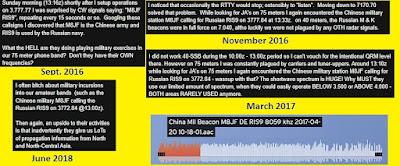Thus far, I have written about UTE's that technically are scattered about the HF shortwave spectrum. However, there are a handful of not-insignificant UTE stations that Pop-Up in the amateur bands; some are even permanent residents.
Case in point: while running a 75-meter frequency (3737.37) in the 2022 CQ W.W. Ssb contest,
an Asian WoODPecker showed up EXACTLY zero-beat with my run frequency - this was clearly
no accident. Consulting the KFS webSDR confirmed its presence and location. As you can see,
the radar pulses created an annoying background disturbance. Switching the 80-mewter 4-Square, the signal was not heard in the N/E, S/E & S/W directions; however, switching the array back to N/W, the woodpecker came in LOUD and CLEAR.
an Asian WoODPecker showed up EXACTLY zero-beat with my run frequency - this was clearly
no accident. Consulting the KFS webSDR confirmed its presence and location. As you can see,
the radar pulses created an annoying background disturbance. Switching the 80-mewter 4-Square, the signal was not heard in the N/E, S/E & S/W directions; however, switching the array back to N/W, the woodpecker came in LOUD and CLEAR.
Also that evening, while running 3747.47, just outside the K3 passband, I heard what sounded like
Cw TFFC being handled. Then I remembered this is a frequency [evidently] claimed for use by the Chinese/Russian air force exercises - why they think the middle of the 75-meter phone band is an
OK place to conduct their exercises is beyond me. As you can see from the above picture, I've written about this before.
Cw TFFC being handled. Then I remembered this is a frequency [evidently] claimed for use by the Chinese/Russian air force exercises - why they think the middle of the 75-meter phone band is an
OK place to conduct their exercises is beyond me. As you can see from the above picture, I've written about this before.
Another Russian military intrusion into the amateur bands are the propagation beacons which permanently reside on ~7.039. Initially I objected to these beacons until it occurred to me that
they can be useful predictions of
band openings to eastern Asia on
40-meters in the middle of the night.
they can be useful predictions of
band openings to eastern Asia on
40-meters in the middle of the night.
While it is a fact that the HF frequency spectrum is a shared resource, it is also true that proper ethical decorum dictates that amateur frequency allocations should be for amateur use ONLY and NoT intruded upon for commercial or military purposes, except MAYBE in a REAL emergency situation.
I've mentioned before that during Ssb radiosport events we also encounter an influx of RTTY stations in segments of the band that are reserved exclusively for amateur voice communications (or Cw); while RTTY signal operations are technically NoT permitted. Most annoying is what I call the "data cranker" - some sort of RTTY or FAX signal that sounds like someone manually cranking out data.
Overall, most UTE incursions on the amateur bands seem to occur [relatively] late at night (West Coast time at any rate), confirming that they are of foreign (i.e., non-U.S.) origin. Because of this, filing reports w/the FCC or Official Observer personnel is probably a waste of time, altho the IARU monitoring people ARE interested; at least back in 2018, at any rate.
In most cases we are fortunate to have plenty of unused band spectrum available to work around many of these incursions. However, when they specifically target a frequency I have been using
for over an hour, that riles my hackles.
for over an hour, that riles my hackles.
Have YOU ever encountered UTE's in the amateur bands?
Tell us about it.




No comments:
Post a Comment